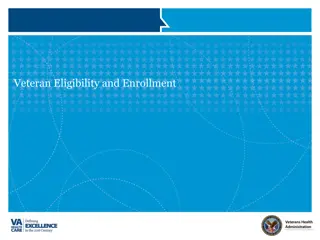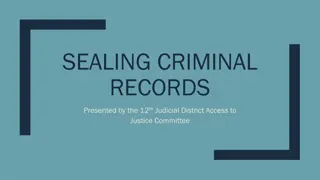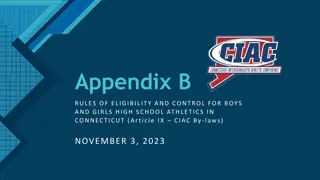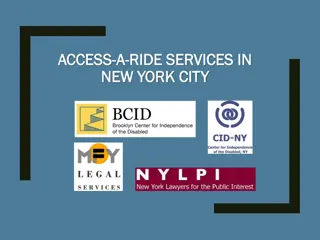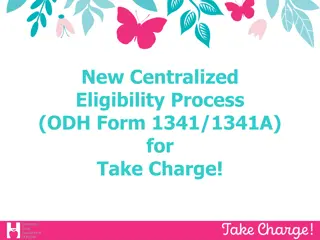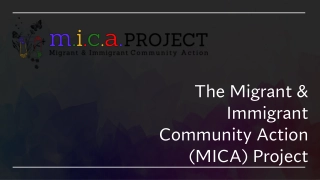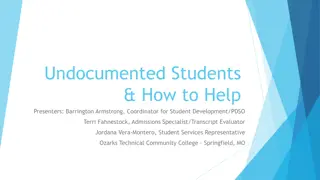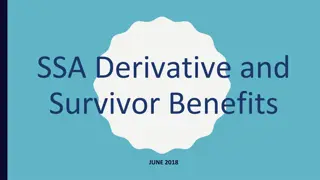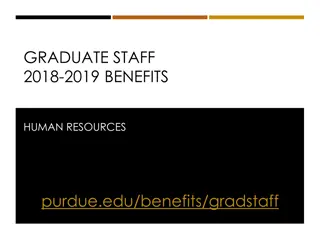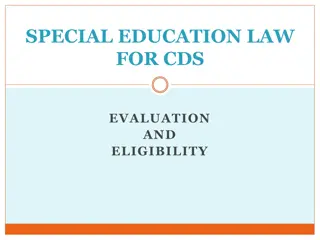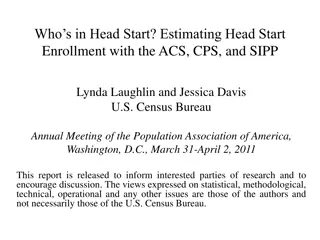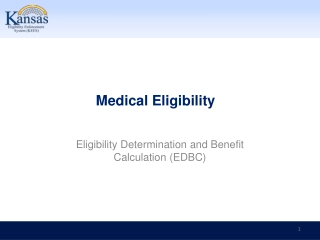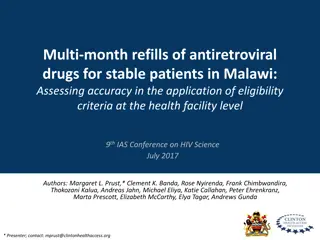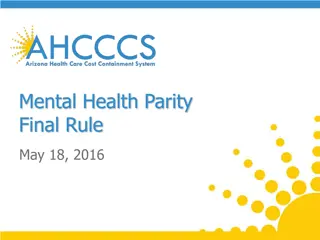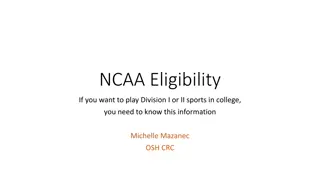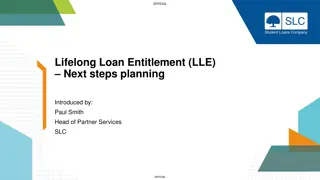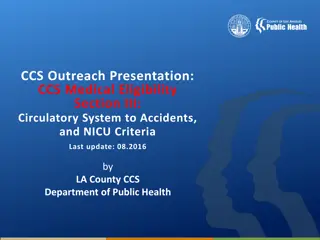Understanding DACA: Eligibility, Benefits, and Limitations
Exploring Deferred Action for Childhood Arrivals (DACA) program guidelines, benefits, and limitations. Discusses eligibility criteria, employment authorization, and what DACA does and does not provide in terms of immigration status. Also, touches upon the proposed expansion of the DACA program.
- DACA program
- Immigration law
- Eligibility guidelines
- Executive branch policy
- Employment authorization
Download Presentation

Please find below an Image/Link to download the presentation.
The content on the website is provided AS IS for your information and personal use only. It may not be sold, licensed, or shared on other websites without obtaining consent from the author. Download presentation by click this link. If you encounter any issues during the download, it is possible that the publisher has removed the file from their server.
E N D
Presentation Transcript
MAKING SENSE OF IMMIGRATION LAW- GETTING DOWN TO BUSINESS, STAYING OUT OF TROUBLE MAY 13, 2015
DEFERRED ACTION FOR CHILDHOOD ARRIVALS ( DACA ) PRESENTED BY SCOTT R. MALYK, ESQ.
THIS IS EXECUTIVE BRANCH POLICY, NOT LEGISLATION DACA THE DREAM ACT The DREAM Act, as proposed, would allow childhood arrivals to obtain green cards DACA simply instructs the executive branch (i.e.; ICE, CBP, USCIS) how to exercise prosecutorial discretion Total initial applications filed 700,000 (as of 9/2014)
WHAT DACA CAN PROVIDE: Deferred Action (a guarantee that removal proceedings will not be initiated or will be closed) for a brief period with a possibility of renewal; and Issuance of Employment Authorization Document (EAD) Provides blanket work authorization to applicant Allows applicant to obtain other important documents like Social Security Card and Driver s License Available only if applicant can show economic necessity NOTE: individuals granted deferred action do NOT accrue unlawful presence for the purpose of INA 212(a)(9)(B) and (C)(i)(I)
WHAT DACA DOES NOT PROVIDE: DACA does not confer a lawful immigration status upon an applicant DACA does not alter existing immigration status DACA does not provide a pathway to citizenship
ORIGINAL ELIGIBILITY GUIDELINES FOR DACA: Were under the age of 31 on June 15, 2012 Arrived in the U.S. before 16thbirthday Can prove they have continuously resided in the U.S. from June 15, 2007 to the present Can prove that they were physically present in the U.S. on June 15, 2012 (and at the time they are requesting deferred action) Entered without inspection or had their lawful immigration status expire before June 15, 2012 (does not include pending applications/petitions) Satisfy the education requirement No felony convictions or 3 or more misdemeanors
THE PROPOSED EXPANSION OF THE DACA PROGRAM Entered the United States before reaching your 16th birthday; Continuously resided in the United States since January 1, 2010 to the present; Were physically present in the United States on June 15, 2012, and at the time of making your request for consideration of DACA w/ USCIS; Had no lawful status as of June 15, 2012; Are currently in school, have graduated or obtained a certificate of completion from high school, have obtained a general education development (GED) certificate, or are an honorably discharged veteran of the Coast Guard or Armed Forces of the United States; Have not been convicted of a felony, significant misdemeanor, or three or more other misdemeanors, and do not otherwise pose a threat to national security or public safety; and Must pass an FBI background check.
DACA EXPANSION IN A NUTSHELL Age cap removed: DACA, as expanded, will apply to all eligible immigrants who entered the U.S. before the adjusted entry date (as long as that entry date was before his/her 16thbirthday), regardless of how old the applicant was on June 15, 2012 or is today. The current DACA program excludes those who were older than 31 on June 15, 2012 (i.e., those who were born before June 15, 1981). That restriction will no longer apply with the expanded guidelines.
DACA EXPANSION IN A NUTSHELL (CONTINUED) Extended validity period of approved deferred action and accompanying work authorization: The period for which DACA and the accompanying EAD is granted is now 3-year increments rather than the previous 2- year increments. This change was made effective November 24, 2014 and applies to all first-time DACA applications as well as all applications for DACA renewal. Beginning on November 24, 2014 USCIS began issuing documents (EADs) valid for three years, including to those individuals who applied prior to the effective date but received an adjudication post-November 24, 2014. employment authorization
DACA EXPANSION IN A NUTSHELL (CONTINUED) Adjusted date-of-entry requirement: To align the DACA program more closely with the proposed Deferred Action for Parental Accountability program, the eligibility cut-off date by which a DACA applicant must have been in the United States will be adjusted from June 15, 2007 to January 1, 2010.
CHALLENGE #1: PROVING CONTINUOUS RESIDENCY You must prove continuous residency in the United States since January 1, 2010 to the present time School or employment records are probative evidence, but not often available May need to get creative with proofs
CHALLENGE #2: DEMONSTRATING PHYSICAL PRESENCE You must prove physical presence in the United States on June 15, 2012, and at the time of making your request for consideration of deferred action with USCIS Similar problems with continuous residency Possible options: bank records, money order history, rental receipts, utility/cell phone bills, dated correspondence, etc.
PRACTICAL REQUIREMENTS FOR FILING DACA CASES Eligible candidates should: File Consideration of Deferred Action for Childhood Arrivals [Form I-821D] File Application for Employment Authorization [Form I-765] With Supplemental Worksheet for DACA [Form I-765WS] Include requisite filing fees payable to Department of Homeland Security of $465.00 $380 is the filing fee $85 is the biometrics fee NOTE: there is an application for a fee waiver in certain cases (e.g. homeless, foster care, excessive medical expenses) **Applications must be filed concurrently or they will be rejected**
DEFERRED ACTION FOR PARENTAL ACCOUNTABILITY ( DAPA ) PRESENTED BY SCOTT R. MALYK, ESQ.
AN OVERVIEW OF THE DAPA PROGRAM USCIS was directed by Executive Order to establish a process similar to DACA for parents of USC and LPR children Deferred Action for Parental Accountability Exercising prosecutorial discretion through the use of deferred action on a case-by-case basis Like DACA, DAPA provides blanket work authorization to otherwise eligible, unauthorized parents who are not enforcement priorities and have been in the country for more than 5 years.
ELIGIBILITY CRITERIA FOR DAPA PROGRAM DAPA eligibility criteria are distinct and apply to certain individuals who: Have a child who is a U.S. citizen or lawful permanent resident born on or before November 20, 2014; Have continuously resided in the United States since before January 1, 2010; Are physically present in the United States on November 20, 2014, and at the time of applying; Have no lawful immigration status on November 20, 2014;
DAPA ELIGIBILITY CRITERIA (CONTINUED) Are not an enforcement priority, which is defined to include individuals with a wide range of criminal convictions (including certain misdemeanors), those suspected of gang involvement and terrorism, recent unlawful entrants, and certain other immigration law violators Memorandum on Policies for the Apprehension, Detention and Removal of Undocumented Immigrants); (See November 20, 2014 Present no other factors that would render a grant of deferred action inappropriate; and Pass a background check.
ROLE OF COUNSEL IN DAPA AND DACA CASES PR ESENTED B Y SC O TT R . M A L Y K , ESQ. A ND M I C HA EL NO R I EGA , E SQ .
ROLE OF COUNSEL FOR THE INDIVIDUAL APPLICANT Is it in your client s best interests to apply for DAPA if the client discloses that he/she has been filing tax returns using a false SSN/ITIN? What if your client presented false documents in connection with the I-9 process (to demonstrate work authorization) to his/her current employer? What if your client has a criminal record? What if your client has made prior immigration filings? How to best advocate for your client s best interests in the face of these issues?
ROLE OF COUNSEL FOR THE EMPLOYER Situation: When employee was originally hired, he/she presented what appeared to be valid work authorization documents. Now the employee comes forward and says my real name is different than the one I used at the time of hire, and here is my new social security card and employment authorization document. How do you counsel this client? Answer: fill out new Form I-9 with the employee (use original hire date in Section 2) and attach a copy of the new supporting documents with a written explanation. Staple all of this to a copy of the original Form I-9. I-9 rules (governed by USCIS) do not require that you terminate the employee for using a false identity.
NAVIGATING NEW POLICIES SUPPORTING U.S. HIGH-SKILLED WORKERS UNDER PRESIDENT OBAMA S EXECUTIVE ORDER PRESENTED BY SCOTT R. MALYK, ESQ.
THE GRANT OF EMPLOYMENT AUTHORIZATION FOR CERTAIN H4 SPOUSES OF H-1B WORKERS Effective May 26, 2015, DHS will extend eligibility for employment authorization to certain, qualifying H-4 spouses of H-1B workers who are in the process of seeking employment-based lawful permanent resident status in the United States. Eligible individuals include H-4 spouses of H-1B workers who: (i) are the principal beneficiaries of an approved Immigrant Petition for Alien Worker (Form I-140); or (ii) have been granted H-1B status (beyond 6 years) on the basis of a PERM application that has been pending with USCIS for at least 365 days. Eligible Authorization (Form I-765) with supporting evidence and the required USCIS filing fees. H-4 spouses must file an Application for Employment
IMMIGRATION CONSEQUENCES OF NEW JERSEY CRIMINAL DISPOSITIONS PRESENTED BY MICHAEL NORIEGA, ESQ.
THE STATISTICS 1982 U.S. deported 413 people based on criminal conviction(s) FY2006 U.S. deported grounds. over 103,163 people based on criminal FY2008 U.S. placed 221,085 people into removal proceedings from Criminal Alien Program
THE STATISTICS 2010 ICE deported 392,862 undocumented foreigners, of whom more than 195,000 were convicted criminals, an increase of more than 23,000 deportations including 81,000 people with criminal records compared with 2008.
2011 DEPORTATIONS US immigration target for 2011: 404.000 deportations, includes screening jails In FY2011, ICE removed 396,906 foreign nationals from the U.S. Of those, 216,698 were convicted of felonies or misdemeanors, including 1119 convicted of homicide, 5,848 convicted of sexual offenses, 44,653 convicted of drug-related crimes, and 35,927 convicted of a DUI (driving under the influence). More than two-thirds of the remaining removals involved individuals who had recently crossed the border or repeat immigration violators. The overall number of foreign nationals removed in FY2011 was the highest in the agency s history.
WHY HAS DEPORTATION BECOME SO MUCH MORE CERTAIN 1996 Amendments to Immigration Law severe for criminal offenses Increased federal enforcement of these laws; and Increased local collaboration-e.g., NJ AG 2007 Law Enforcement Directive for inquiring about immigration status of arrested persons.
IMMIGRATION CONSEQUENCES OF CRIMINAL OFFENSES HAVE GOTTEN WORSE Deportation mandatory after some crimes Detention - mandatory after some crimes Bars after crimes re-entry, waivers, asylum, relief from deportation Limited judicial review of removal order. Future penalties enhanced re-entry penalty Bar to U.S. citizenship-for several years or even permanently
Gaitan Nunez- Valdez Padilla
QUESTIONS: What are my obligations when I have a client who is not a US citizen? What do I need to ask? What follow up questions do I need to know once I find out their status? What is the difference between a greencard and citizenship? What happens if the criminal matter is dismissed-does the client still face deportation?
TRAINING PURPOSE Review new responsibilities after Padilla v. Kentucky for Criminal Defense attorneys. Immigration primer Fundamentals. How to avoid pleas and sentences that will lead to deportation. From Municipal Court to Superior Court
AGENDA i. Responsibilities of the Criminal Defense Attorney ii. Effectively Representing an Alien in Criminal Matters iii. Consequences beyond the criminal case iv. Resources
PADILLA AND BEYOND: DEFENSE COUNSEL S NEW RESPONSIBILITIES
SUMMARY OF PADILLA Padilla was an Lawful Permanent Resident (LPR) facing deportation for CDS offense involving Marijuana. Defendant Claimed counsel: Counsel failed to properly advise of imm consequences. Counsel misadvised when counsel said you ve been in the country a long time, you don t have to worry. Padilla claimed he relied on erroneous advice when he plead guilty, making deportation mandatory.
SUMMARY OF PADILLA (CONT.) USSC disagreed with the Kentucky Supreme Court and agreed with Padilla s argument that: Constitutionally competent counsel would have advised him that his conviction for drug distribution made him subject to automatic deportation. The drastic measure of deportation or removal is now virtually inevitable for a vast number of noncitizens convicted of crimes.
SUMMARY OF PADILLA (CONT.) Due to these drastic results, the Court held that accurate legal advice for noncitizens accused of crimes has never been more important Deportation is an integral part-indeed, sometimes the most important part-of the penalty that may be imposed on noncitizen defendants who plead guilty to specified crimes. The court found that the consequences were sufficiently clear and that the attorney s conduct therefore fell below the reasonableness standards pursuant to the Strickland analysis.
IMPACT ON CRIMINAL DEFENSE ATTORNEYS Advice regarding immigration consequences covered by 6th Amendment because deportation is a particularly severe penalty that is intimately related to criminal process. Defense counsel must rely on their existing professional standards for what constitutes effective assistance of counsel.
IMPACT ON CRIMINAL DEFENSE ATTORNEYS Criminal defense counsel must provide affirmative and competent advice regarding immigration consequences; non-advice (SILENCE) is insufficient (ineffective). Informed consideration of the immigration consequences is sanctioned as a valid tool to accomplish plea negotiations in resolving criminal matters.
CRIMINAL DEFENSE ATTORNEY RESPONSIBILITIES A. Duty to inquire about citizenship/immigration status at initial interview stage. B. Duty to investigate and advise of immigration consequences of plea alternatives C. Duty to investigate and advise of immigration consequences of sentencing alternatives.
IMPACT IN NEW JERSEY: STATE V. GAITAN Holding: Padilla is a new constitutional rule-therefore not entitled to retroactive application on collateral review. (Contrary to 3rd Circuit decision in U.S. v. Orozio, 645 F.3d 630). Although Padilla will not apply retroactively on collateral review, Nu ez- Vald z did not announce a new rule and governs the standard of attorney performance in New Jersey in ineffective assistance of counsel claims on collateral review. Strickland analysis still controlling standard for ineffective assistance (conduct falling below objectively reasonable standard + prejudice) Padilla was not merely an application of Strickland to new facts, but an announcement that counsel must give affirmative advice about consequences outside of criminal prosecutions.
IMPACT IN NEW JERSEY: STATE V. GAITAN Even if removal is not mandated, counsel must highlight for noncitizen clients that entering a guilty plea will place them at risk of removal and that they may seek legal advice on potential immigration consequences. Finally, under Nu ez-Vald z, if counsel provided affirmatively misleading advice about the removal consequences of a guilty plea, then deficiency may exist for purposes of establishing a prima facie ineffective assistance of counsel claim entitling defendant to an evidentiary hearing in a PCR proceeding.
WHO IS AT RISK OF DEPORTATION OR OTHER NEGATIVE IMMIGRATION CONSEQUENCES? Answer: Any non-citizen
YOUR CLIENT IS A NONCITIZEN IF S/HE WAS BORN OUTSIDE THE U.S. UNLESS: Born Abroad to USC parents Derivative citizenship through parents; or Lawful immigration and naturalization
WHAT ARE THE VARIOUS TYPES OF IMMIGRATION STATUS THAT A NON-CITIZEN MAY HAVE?
IMMIGRATION STATUS- MAJOR CATEGORIES: 1. Lawful permanent resident (LPR, or green card holder) 2. Refugee or asylee 3. Temporary visitor (on student, business, or other visa) 4. Undocumented status, (e.g., crossed the border without inspection or overstayed temporary visa admission
SUMMARY OF QUESTIONS TO ASK AT FIRST CONSULT Place of Birth Country of Birth (don t assume these first two are the same) Nationality of Parents First entry into the US Status at first entry Current Status Parents in US? Status? Spouse? Status? Children? Status?
B. CONSIDERATIONS BEFORE ENTERING PLEA FOR NON-CITIZEN CLIENT STATUS CONTROLS CONSEQUENCES
DEPORTABILITY V. INADMISSIBILITY Deportability alien who has been properly admitted into US has to be deemed deportable by government. Inadmissibility alien who has been neither inspected or admitted. Certain crimes render alien inadmissible thereby preventing entry, admission or adjustment





